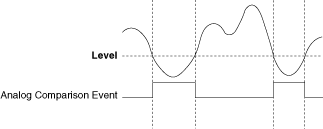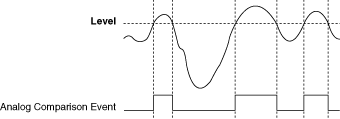
You can configure the analog trigger circuitry to different triggering modes.
You can configure the analog trigger circuitry to detect when the analog signal is below or above a level you specify.
In below-level analog triggering mode, the trigger is generated when the signal value is less than Level.

In above-level analog triggering mode, the trigger is generated when the signal value is greater than Level.

Hysteresis adds a programmable window above or below the trigger level that a valid trigger signal must pass through and is often used to reduce false triggering due to noise or jitter in the signal.
When using Hysteresis with a rising slope, the trigger asserts when the signal starts below Level and then crosses above Level. The trigger deasserts when the signal crosses below Level minus hysteresis.

When using Hysteresis with a falling slope, the trigger asserts when the signal starts above Level and then crosses below Level. The trigger deasserts when the signal crosses above Level plus hysteresis.

A window trigger occurs when an analog signal either passes into (enters) or passes out of (leaves) a window defined by two voltage levels. Specify the levels by setting the window Top value and the window Bottom value.
The following figure demonstrates a trigger that asserts when the signal enters the window.
